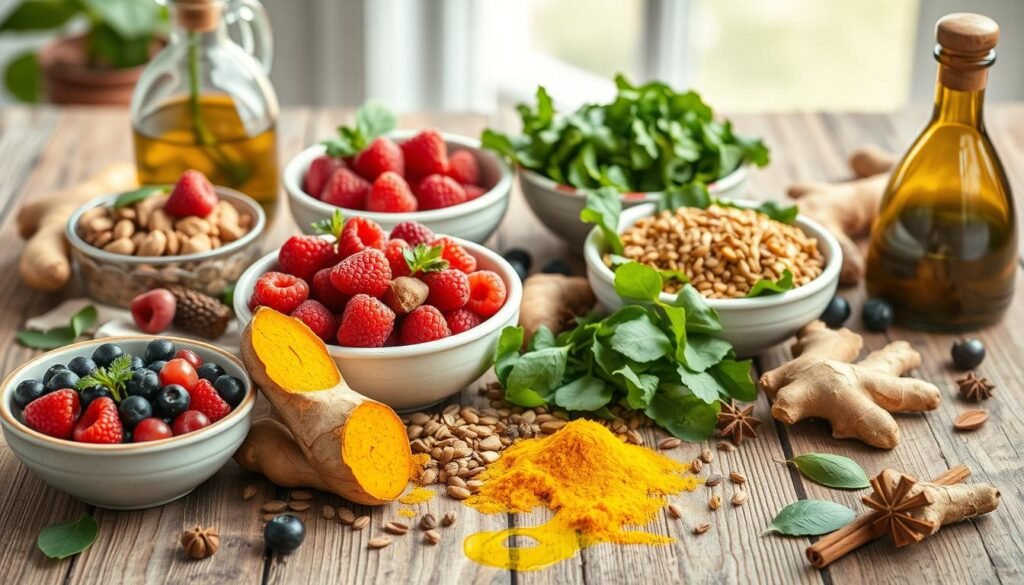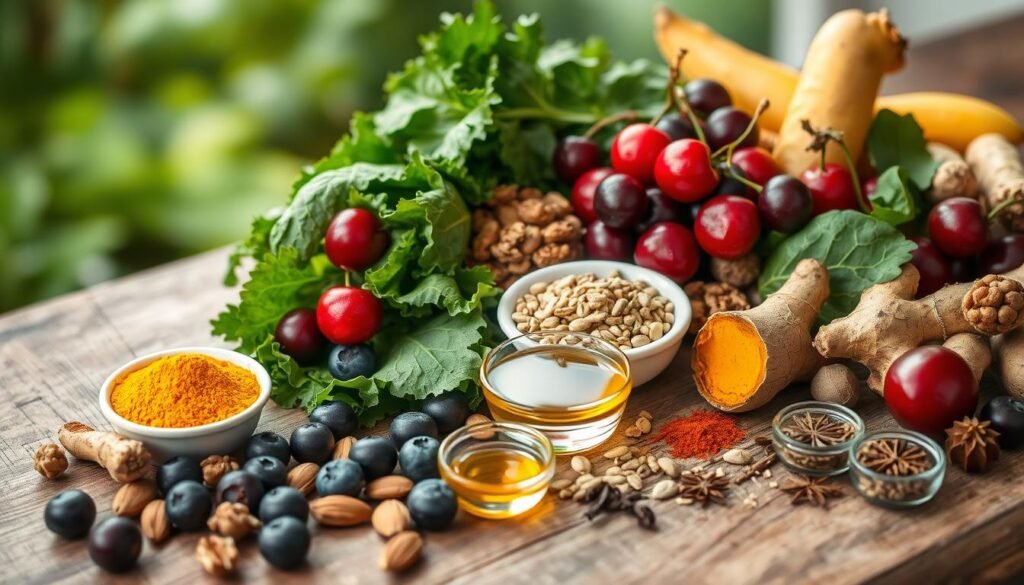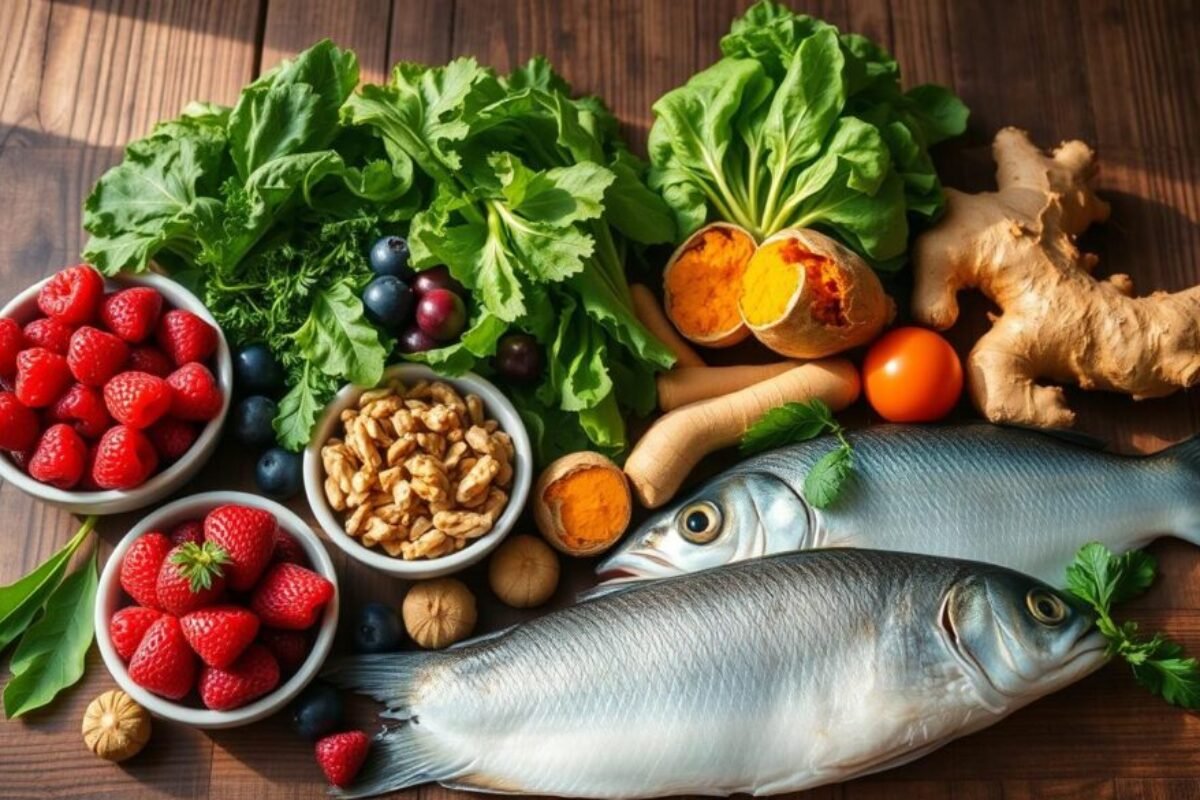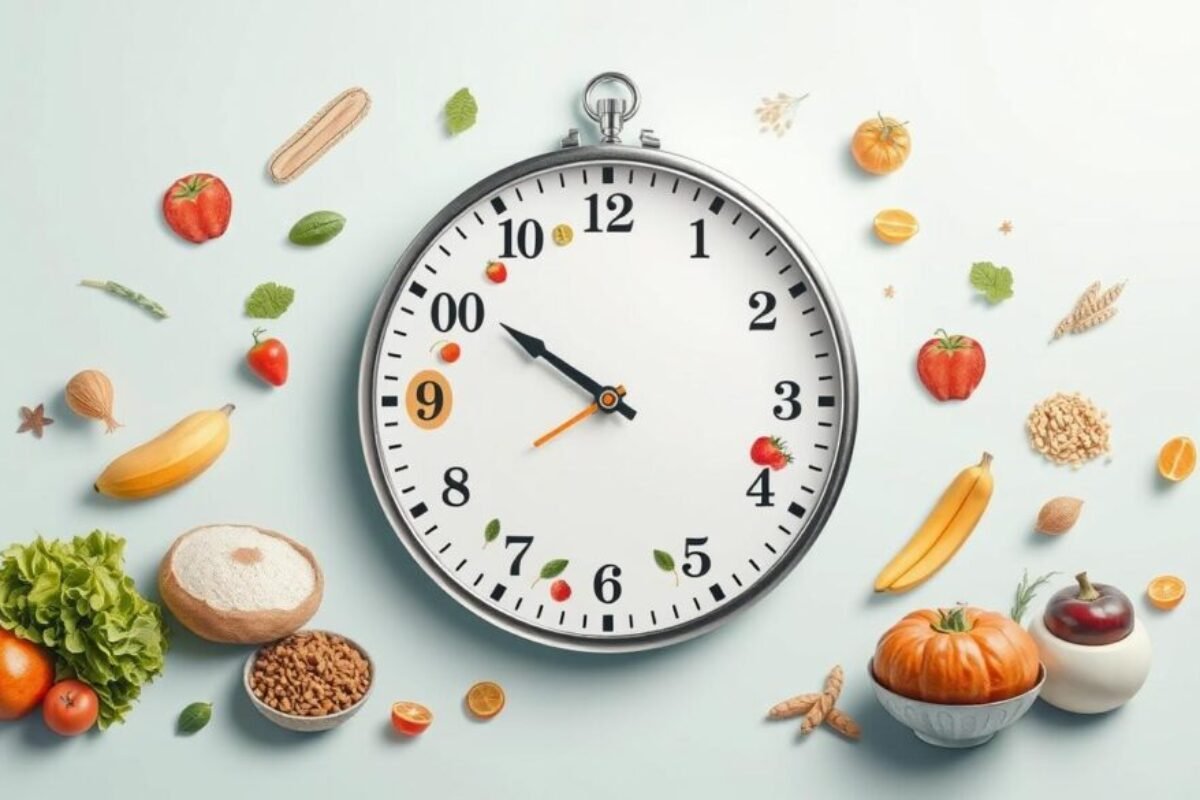The Role of Anti-Inflammatory Foods in Health and Fitness in 2024
In the last century, human life expectancy has doubled worldwide thanks to medicine1. But, our modern lifestyle has introduced a new enemy: chronic inflammation. This silent foe is linked to diseases like cancer, heart disease, and brain decline1. In the U.S., heart disease is the top killer, with inflammation playing a big role1. Cancer also sees inflammation as a friend, helping it grow1. And, inflammation can harm our brains, raising the risk of brain diseases1.
In 2024, the importance of anti-inflammatory foods is clear. Changing what we eat can fight inflammation and keep us healthy1. Diets like the Mediterranean or DASH can lower inflammation and boost health1. On the other hand, diets rich in processed foods, fats, sugars, and artificial sweeteners fuel inflammation1. These diets also lead to insulin resistance and metabolic syndrome due to their high sugar and refined grain content1. Plus, they’re high in sodium and low in potassium, raising the risk of high blood pressure, stroke, and certain cancers1.
Key Takeaways
- Chronic inflammation significantly contributes to the development and progression of noncommunicable diseases.
- Anti-inflammatory diets, like the Mediterranean diet or DASH diet, are effective in reducing inflammation and improving health.
- Proinflammatory diets, high in processed meats, saturated fats, sugars, and artificial sweeteners, contribute to chronic inflammation.
- Dietary modifications can help reduce systemic inflammation and are critical for overall health management.
- The Empirical Dietary Inflammatory Index (EDII) can help classify dietary patterns into anti-inflammatory and proinflammatory categories.
Understanding Inflammation: The Body’s Double-Edged Sword
Inflammation is a key survival tool, but too much can harm us. Acute inflammation is a quick response to injury or infection, lasting hours to days. Chronic inflammation is when this process goes on too long, damaging organs over time2.
Acute vs. Chronic Inflammation
Acute inflammation is good, protecting us from harm. But chronic inflammation is bad, lasting too long and causing damage. It’s linked to many diseases, like heart disease and diabetes2. Knowing the difference is key to staying healthy.
Impact on Overall Health
Chronic inflammation quietly harms us over years or decades, without clear signs2. It’s behind many illnesses, including heart disease and diabetes3. Almost every disease is linked to inflammation, and scientists are studying it closely3.
Common Triggers of Inflammation
Many things can start chronic inflammation, like free radicals and infections. The gut microbiome might also play a role, linked to diseases like Parkinson’s3. Changes in diet and lifestyle can affect our gut, leading to diseases like obesity and diabetes3.
“Understanding how inflammation is induced in the gut may help address challenges like antibiotic resistance.”3
Anti-inflammatory Diet 2024: Latest Research and Guidelines
In 2024, the focus on anti-inflammatory diets is stronger than ever. This is thanks to new studies showing their importance in preventing and treating diseases4. These diets include lots of fruits, veggies, whole grains, and lean proteins. They also cut down on processed foods, sugars, and fats4.
The Mediterranean, DASH, and Okinawan diets are top choices for reducing inflammation5. They are known for their health benefits.
These diets suggest eating 1-2 servings of fruits and veggies at each meal. Protein should mainly come from legumes and lean meats5. Red meat should be eaten only once a week or less, as studies show it raises the risk of stroke and heart disease.
Research shows that an anti-inflammatory diet can lower dementia risk by 31%6. It also helps those with diabetes, heart disease, or stroke to avoid dementia for 2 years longer than those who eat pro-inflammatory foods. Plus, it can reduce inflammation symptoms like pain, swelling, and stomach problems5.
The science is clear: eating anti-inflammatory foods can fight free radicals and lower body inflammation45. By following an anti-inflammatory diet in 2024, you can boost your health and feel better overall.
How Anti-Inflammatory Foods Combat Chronic Disease
Anti-inflammatory foods are key in fighting chronic diseases like heart disease, cancer, and arthritis. They help reduce inflammation, which is good for our health and well-being over time.
Heart Disease Prevention
Heart disease often starts with inflammation in the arteries. Foods like fatty fish, nuts, and leafy greens can fight this inflammation. This can lower heart disease risk7. A Mediterranean diet, full of these foods, also lowers inflammation markers8.
Cancer Risk Reduction
Inflammation can help cancer grow. Eating anti-inflammatory foods can help control our immune system. This might lower cancer risk7. Vegetarian and vegan diets are also linked to less inflammation than meat-based diets8.
Arthritis Management
For those with arthritis, anti-inflammatory foods can ease pain and swelling. They also help keep the gut healthy, which is important for inflammation levels7. Diets like the Mediterranean and DASH can help with arthritis and other autoimmune diseases8.
Eating anti-inflammatory foods daily can help fight chronic diseases. They improve our health in many ways, from preventing heart disease to managing arthritis. These foods are a powerful way to enhance our long-term health.
Essential Components of an Anti-Inflammatory Diet
Keeping a healthy diet is key to fighting chronic inflammation and boosting well-being9. Over half of Americans have a chronic disease, showing the diet’s role in managing inflammation9. Fruits, vegetables, whole grains, and unsaturated fats are all important for reducing inflammation and improving health.
Omega-3 fatty acids in fatty fish like salmon are strong anti-inflammatory agents9. They lower the risk of heart disease and some cancers9. Plant-based sources like flaxseeds, chia seeds, and walnuts also offer omega-3 benefits.
An antioxidant-rich diet, with berries, leafy greens, and more, fights oxidative stress and inflammation10. Vitamin C in fruits and veggies helps combat cellular damage that leads to inflammation10. Polyphenols in coffee, tea, and dark chocolate also have anti-inflammatory effects.
Gut health is linked to inflammation, and fiber-rich foods like whole grains and legumes help keep the gut healthy10. Foods rich in probiotics and prebiotics support beneficial gut bacteria, reducing inflammation10.
Herbs and spices, such as garlic, ginger, and turmeric, add to an anti-inflammatory diet with their anti-inflammatory compounds10. Adding these to your meals can help fight inflammation and support health.

| Anti-Inflammatory Foods | Key Nutrients | Health Benefits |
|---|---|---|
| Fatty fish (salmon, mackerel, sardines, tuna) | Omega-3 fatty acids | Reduced risk of heart disease and certain cancers |
| Berries (blueberries, raspberries, strawberries) | Antioxidants, vitamin C | Combat oxidative stress and inflammation |
| Leafy greens (spinach, kale, collards) | Antioxidants, vitamins | Reduce inflammation and support overall health |
| Whole grains (brown rice, quinoa, oats) | Fiber, vitamins, minerals | Maintain gut health and reduce inflammation |
| Nuts and seeds (walnuts, flaxseeds, chia seeds) | Omega-3s, antioxidants | Combat inflammation and support heart health |
| Garlic, ginger, turmeric | Anti-inflammatory compounds | Reduce inflammation and promote overall wellness |
“Incorporating a variety of anti-inflammatory foods into your diet can have a profound impact on your overall health and well-being.” – Nutrition Expert,
The Science Behind Food-Induced Inflammation
Learning about how food causes inflammation is important for our health. It helps us choose better foods. We can track inflammation markers and learn about gut health to improve our well-being.
Inflammatory Markers
Food high in refined carbs and sugars can lead to inflammation. It triggers the release of molecules like cytokines and prostaglandin E211. These molecules are key in our body’s fight against inflammation.
Metabolic Response
Eating too much sugar and refined grains makes our body produce more insulin11. This hormone can cause inflammation. It can also lead to diseases like type 2 diabetes and heart problems.
Gut Health Connection
The gut microbiome is vital for controlling inflammation11. Foods rich in fiber help our beneficial bacteria. But, a diet full of processed foods can upset our gut balance, causing more inflammation.
Also, the diet’s acid load affects inflammation. Anti-inflammatory diets tend to have a lower acid load, which is good for our health.
By grasping the science of food-induced inflammation, we can make better choices. This helps us stay healthy and lowers the risk of chronic diseases11.
Top Anti-Inflammatory Foods for Optimal Fitness
To fight inflammation and reach your fitness goals, eating anti-inflammatory foods is key. These foods are packed with nutrients. They help reduce inflammation, aid in recovery, and boost your overall health121314.
Begin your day with berries. They are great at lowering inflammation markers and stopping pro-inflammatory pathways in the body12. Dark chocolate, with a high cacao content, is also a tasty choice. It has been shown to lower inflammatory markers like hs-CRP, TNF-α, and IL-612.
Throughout the day, choose anti-inflammatory superfoods like leafy greens, salmon, and turmeric. Leafy greens can greatly lower CRP and boost anti-inflammatory compounds in the blood12. Salmon, mackerel, and sardines are rich in omega-3s. These fats help reduce inflammatory compounds14. Turmeric, with curcumin, can significantly lower CRP and ESR in those with inflammatory diseases12.
Nuts, seeds, and legumes are also beneficial. Almonds, walnuts, chia seeds, and flaxseeds offer healthy fats and fiber to fight inflammation14. Beans and lentils boost anti-inflammatory substances in the gut12.
Adding these top anti-inflammatory foods to your diet can reduce inflammation from exercise. It helps you recover faster and supports your fitness journey.

“Eating a diet rich in anti-inflammatory foods can be a powerful way to support your fitness and overall health. By reducing systemic inflammation, you can improve recovery, reduce the risk of injury, and feel your best during your workouts and throughout your day.”
Pro-Inflammatory Foods to Avoid in Your Diet
A balanced diet rich in anti-inflammatory foods is key to good health15. But, it’s also important to watch out for foods that can harm you15. Sadly, nearly 6 in 10 Americans eat diets that are bad for them15. This puts them at risk for serious health problems like heart disease, cancer, and arthritis15.
Hidden Sources of Inflammation
Processed meats, high-fat dairy, refined sugars, and artificial sweeteners are bad for you16. The average American diet gets up to 40% of its calories from added sugars and refined carbs16. This can mess with your hormones and metabolism16. Foods with emulsifiers can also hurt your gut, causing more inflammation15.
Common Dietary Mistakes
Eating too much sodium and not enough potassium can lead to inflammation and high blood pressure16. The Western Diet, full of bad foods and snacks, causes chronic inflammation15. To fight this, eat more omega-3s, fiber, and colorful fruits and veggies15.
| Pro-Inflammatory Foods to Avoid | Healthier Alternatives |
|---|---|
| Processed meats (e.g., bacon, sausage, deli meat) | Lean, fresh meat, poultry, or fish |
| High-fat dairy products (e.g., cheese, butter, cream) | Low-fat or non-fat dairy options |
| Refined sugars (e.g., soda, candy, baked goods) | Fresh fruits, honey, or natural sweeteners |
| Artificial sweeteners (e.g., aspartame, sucralose) | Stevia or monk fruit sweetener |
| Refined grains (e.g., white bread, pasta, pastries) | Whole grains (e.g., brown rice, quinoa, oats) |
| Fried foods and baked goods with trans fats | Healthy unsaturated fats (e.g., olive oil, avocado, nuts) |
| Alcoholic beverages | Water, herbal tea, or non-alcoholic alternatives |
By avoiding these bad foods and choosing better ones, you can improve your health15. A diet rich in anti-inflammatory foods is not just a trend. It’s a way to live longer and feel better15.
Implementing Anti-Inflammatory Eating Patterns
To fight inflammation and boost health, we can start eating anti-inflammatory foods every day17. Our meal plan is 1,500 calories a day, good for losing weight for most people17. For those needing more calories, we offer a 2,000-calorie plan17. But, eating only 1,200 calories a day is too little for most, says the 2020-2025 Dietary Guidelines for Americans.
We should eat more fruits, veggies, whole grains, and lean proteins. We should also eat less processed and sugary foods18. The typical American diet has 40-80% calories from bad foods18. Following the Mediterranean diet can lower inflammation and pain in chronic conditions.
- Aim for 1-2 servings of fruits and vegetables at each meal.
- Add anti-inflammatory spices like turmeric and ginger to your cooking.
- Switch to whole grains and lean proteins like fish and legumes instead of red meat.
- Watch your portion sizes and snack less.
- Try the Mediterranean or DASH diet for anti-inflammatory benefits.
| Food Category | Recommended Intake |
|---|---|
| Protein | 54g to 101g per day17 |
| Carbohydrates | 141g to 180g per day17 |
| Fiber | 31g to 44g per day17 |
| Fat | 60g to 86g per day17 |
By following these anti-inflammatory eating tips, we can improve our diet and fitness recovery19. This diet is meant to be a long-term change for better health19. Long-term inflammation can harm healthy cells and may lead to autoimmune diseases.

“Adopting an anti-inflammatory diet can be a game-changer for those seeking to improve their health and fitness. The benefits go far beyond weight management, supporting the body’s natural ability to recover and thrive.”
Measuring the Impact: The Empirical Dietary Inflammatory Index
Knowing how our diets affect inflammation is key to staying healthy. The Empirical Dietary Inflammatory Index (EDII) helps us see how our food choices impact us20. It looks at 18 food groups, half of which are anti-inflammatory and half pro-inflammatory, to judge our diet.
Understanding Your Score
Your EDII score tells you about your diet’s inflammatory level. A score above 0 means your diet is pro-inflammatory. A negative score means it’s anti-inflammatory20. The study showed 49% of people need to change their diet because of their score20.
Making Dietary Adjustments
To lower inflammation, eat more anti-inflammatory foods like leafy greens and berries. Also, eat more fatty fish. Cut down on refined grains, processed meats, and sugary foods20. These changes can make your diet better and improve your health.
Knowing your EDII score is just the start. By changing your diet wisely, you can control your health. Start an anti-inflammatory lifestyle today and reach your health goals in 2024 and beyond.
Conclusion
As we look ahead to 2024, starting an anti-inflammatory diet is a smart move for better health and fitness. Research shows how food choices can greatly affect our health, either positively or negatively21.
Learning about how food causes inflammation and eating anti-inflammatory foods can help a lot. It can lower the risk of long-term diseases and boost our fitness2122. The benefits of eating to reduce inflammation are clear, making it key for keeping healthy and managing diseases.
In the future, the focus on an anti-inflammatory diet 2024 will likely grow. We’ll keep learning how to use food to improve our health for years to come. With ongoing research, we’ll get better advice and new ways to fight inflammation and stay healthy.





March 15, 2025 @ 2:21 am
I don’t think the title of your article matches the content lol. Just kidding, mainly because I had some doubts after reading the article.
March 16, 2025 @ 9:56 am
Your point of view caught my eye and was very interesting. Thanks. I have a question for you.
April 5, 2025 @ 12:31 am
Your article helped me a lot, is there any more related content? Thanks!
August 17, 2025 @ 8:38 pm
Can you be more specific about the content of your article? After reading it, I still have some doubts. Hope you can help me.
August 24, 2025 @ 9:13 pm
Thanks for sharing. I read many of your blog posts, cool, your blog is very good.